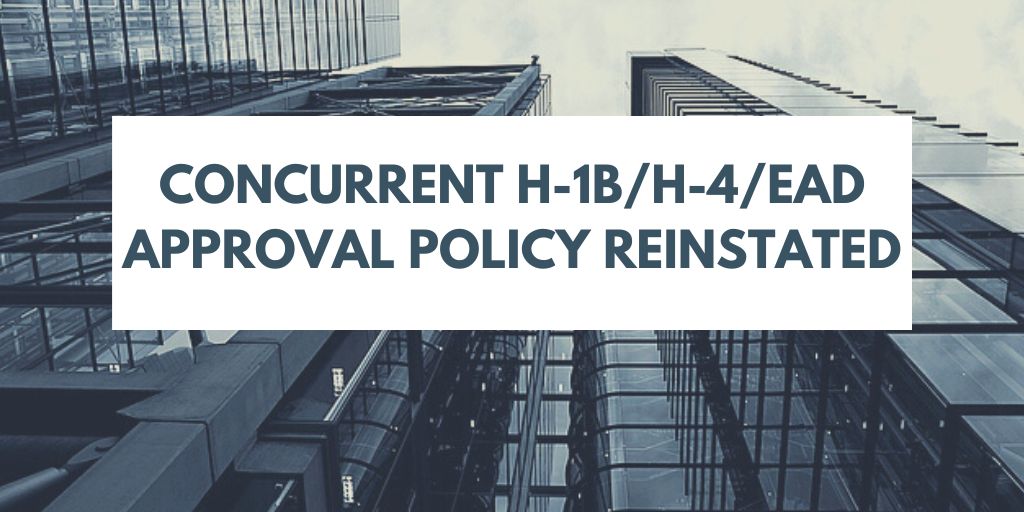USCIS to Reinstate Policy Allowing Concurrent Approval of H-1B and H-4/EAD Applications
In a legal settlement USCIS has agreed to reinstate its procedure to “bundle” and review concurrently spouses’ H-4/EAD and L-2/EAD applications when such applications are filed concurrently with an underlying I-129 petition seeking H-1B (or L-1) for the primary worker. This is great news for H-4/L-2 spouses who rely on EADs to work in the US and provides another option for ensuring uninterrupted (or minimal interruption) period of H-4 or L-2 EAD employment authorization.
Update: The Edakunni settlement is set to expire on January 18, 2025. See our alert.
The two-year settlement agreement in the Edakunni v. Mayorkas litigation is expected to become effective on January 25, 2023 and should apply to petitions filed both under premium and regular processing. We expect announcement by USCIS and we anticipate that they will amend their procedure on an ongoing policy well beyond the 2-year settlement period.
Background
Prior to March 2019, USCIS’s policy was to generally adjudicate I-129 petitions (for H-1 or L-1) at the same time with concurrently-filed I-539 (for H-4 or L-2) and I-765 (for H-4 EAD and L-2 EAD) applications and this policy applied to both regular and premium processing filings. This allowed a fair amount of predictability as far as the timing of H-4/EAD renewals is concerned as H-4 spouses knew that they can secure renewal in as little as a few weeks and to ensure uninterrupted work authorization.
The policy was changed in 2019 where I-539 and I-765 were “unbundled” even if they were filed concurrently with an I-129 petition and due to the increasing processing times, many H-4/L-2 spouses found themselves waiting for 6-12 (sometimes more) months for H-4 EAD approval and this meant that they had to stop working temporarily or altogether lose their jobs. The introduction of biometrics requirement for H-4 and L-2 applications further added to the major delays. Overall, since 2019, H-4 (and L-2) EAD spouses have faced major challenges in ensuring continuing work authorization.
In a November 2021 USCIS Shergill settlement, USCIS agreed to consider employment to be authorized incident to L-2 status; as a result, L-2 spouses did not need to obtain an EAD to be able to work (EAD is still required for H-4 spouses). In November 2021 USCIS agreed to allow work authorization only for certain pending H-4 EAD extensions and in limited circumstances where the applicant had already been granted H-4 status. See our alert.
Terms of the January 2023 Settlement
The new settlement agreement is very short but in essence it requires USCIS to bundle the adjudication of Forms I-539 and I-765 with the underlying I-129 petition when these applications are properly filed together regardless of whether the I-129 petition requests regular or premium processing. USCIS will not review together I-539 and I-765 applications if they are not filed separately or improperly (such as missing items such as photos, required document, checks, etc.). The settlement is set to become effective on January 25, 2023 and has a two-year validity term.
USCIS is expected to announce more details on the implementation of this settlement and we will publish them here as soon as they are available – stay tuned.
Practical Considerations
As a practical matter, we recommend filing concurrent H-4 and H-4 EAD petitions where available with the underlying I-129 petition especially where the I-129 petition is filed with premium processing. It is critical to ensure that the H-4 and H-4 EAD applications are well-prepared and documented to avoid “separation” of the cases due to an RFE. If an H-4 (or H-4 EAD) application is not perfect, it is very likely that the H-4/EAD applications will be separated from the I-129 and will “lose” the benefit of this new concurrent approval policy.
Unfortunately, in certain cases filing the H-1B petition with premium process is not an option — for example, certain employers will not allow filing for H-1B with premium processing unless certain criteria area met. Or, perhaps it is not possible to file the H-4 and H-4 EAD concurrently with the H-1B – again, some employers do not allow the concurrent filing of H-4 and H-4 EAD with the primary H-1B (even if they allow for premium processing).
When premium processing is not an option (or perhaps in other case-specific situations) there are additional options for ensuring continuing H-4 EAD work authorization. For example, getting H-4 status by travel abroad and reentry into the US after H-1B approval followed by a timely filing of an H-4 EAD extension still authorizes employment (see our alert). Our office can certainly provide guidance and strategies on the best course of action.
Conclusion/Further USCIS Guidance Anticipated
The Edakunni settlement is excellent news for a number of H-4 (and L-2) spouses who now have additional alternatives to avoid or minimize disruption to their employment due to USCIS processing delays.
Our office will continue to monitor and report developments on this and related topics. Please do not hesitate to contact us, schedule a phone consultation, or if we can help with an H-4 EAD application filing (request quote here). Also, please subscribe to our free weekly newsletter to ensure that you obtain this and related immigration-related news and announcements.
Related News and Articles
The Capitol Immigration Law Group has been serving the business community for over 15 years and is one of the most widely respected immigration law firms focused solely on U.S. employment-based immigration. Disclaimer: we make all efforts to provide timely and accurate information; however, the information in this article may become outdated or may not be applicable to a specific set of facts. It is not to be construed as legal advice.

